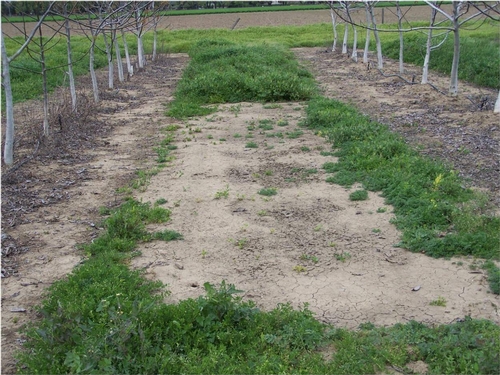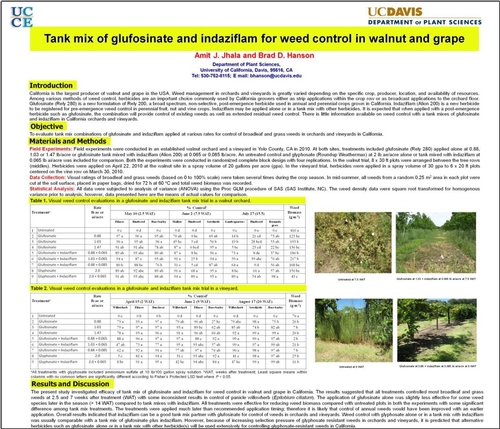I visited a couple herbicide trial sites in orchards and vineyards yesterday and saw some interesting results that follow up on my post from February 21, 2011. In that post, I discussed some 2010 work where we evaluated a number of residual herbicides applied in combination with a fairly high rate of glyphosate. You can see that poster presentation from the WSSA meeting here. As I drove past the walnut orchard trial from 2010, I had to slam on the brakes and go investigate the plot in the photo below.

After a little investigation, I determined that our application of 2 lb ae/A glyphosate plus 0.085 lb ai indaziflam (6.5 fl oz Alion) still had very good weed control nearly 12 months after the April 2010 application! I don't think I'd count on getting 12 full months of control every time with this herbicide but it looks like it will be a nice herbicide for growers to consider.
Alion is expected to be registered in tree nuts this year well before fall herbicide preemergence treatments are applied. FYI - I have a similar trial in a nearby orchard that we will be presenting at the 2011 UC Davis Weed Day on July 14, 2011

Take care,
Brad
Tank mix of glufosinate and indaziflam for weed control in walnut and grape
Amit J. Jhala and Brad D. Hanson
Abstract
Herbicides are an important component of integrated weed management in orchards and vineyards. Indaziflam is a new active ingredient to be registered for residual control of broadleaf and grass weeds in perennial fruit, nut and vine crops and can be applied alone or with POST herbicides such as glufosinate, glyphosate etc. In 2010, field experiments were conducted to evaluate weed control with several rate combinations of glufosinate and indaziflam in a walnut orchard and a vineyard in Yolo County, CA. At both the sites, treatments included glufosinate (Rely 280) applied alone at 0.88, 1.03 or 1.47 lb ai/acre or tank mixed with indaziflam (Alion 200) at 0.065 or 0.085 lb ai/acre. An untreated control and glyphosate (Roundup Weathermax) at 2 lb ae/acre alone or tank mixed with 0.065 lb ai/acre indaziflam were included for comparison. Visual ratings of weeds were taken several times during the season and weed biomass was taken on 6 Aug. and 16 July, 2010 respectively in the walnut and grape trials. The results revealed that all treatments resulted in more than 90% control of filaree (Erodium spp.), California burclover (Medicago polymorpha), chickweed (Stellaria media), and hare barley (Hordeum murinum ssp. Leporinum) three weeks after treatment (WAT). The application of glufosinate alone was slightly less effective later in the season for some weed species compared to tank mixes with indaziflam. For example, late emerging weeds like common lambsquarters (Chenopodium album) in the walnut trial and sharppoint fluvellin (Kickxia elatine) in the grape trial were not controlled with an application of glufosinate at any rate, but were controlled 15 to 20 WAT with a tank mix of indaziflam with glufosinate or glyphosate. However, for winter annual weed species such as sowthistle (Sonchus spp.) and hairy fleabane (Conyza bonariensis) present at the time of application, there were usually no significant differences among treatments. All treatments were effective for reducing weed biomass compared with untreated plots with the lowest weed biomass in a tank mix of glyphosate with indaziflam which was comparable with some tank mix treatments. The limitation of this study was application of herbicide was much later (March and April, respectively in grape and walnut trial) than the recommended time, therefore it is likely that control of annual weeds would have been improved with an earlier application. Glyphosate alone or in combination with indaziflam provided similar control of broadleaf and grass weeds compared to tank mixes of glufosinate and indaziflam; however, these two locations did not have any known glyphosate resistant weed species. Herbicides with alternate mode of action such as glufosinate alone or in a combination with residual herbicide such as indaziflam may provide useful tools for growers to manage a broad spectrum of weeds, including glyphosate-resistant biotypes, in orchards and vineyards.
Attached Files: